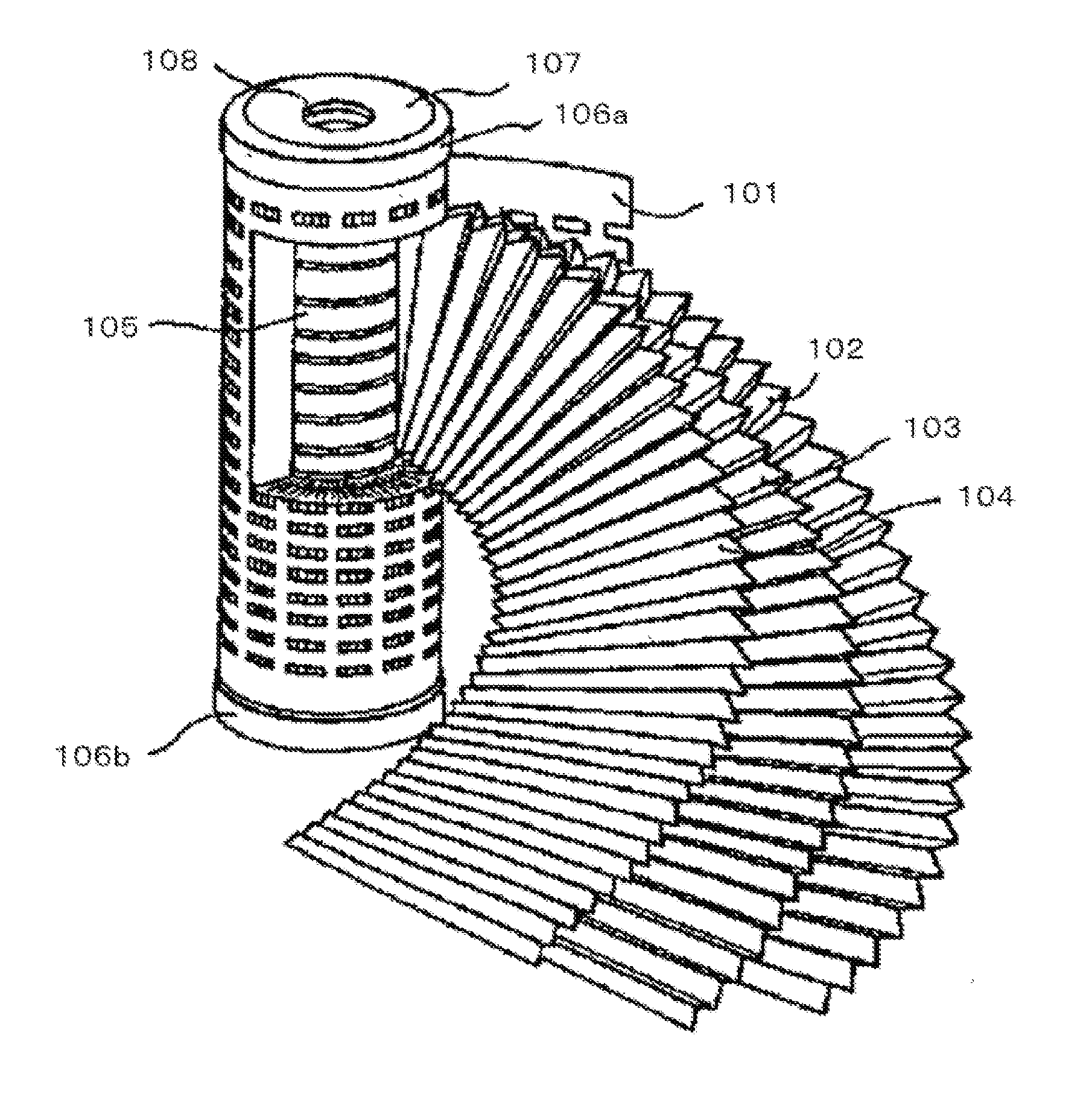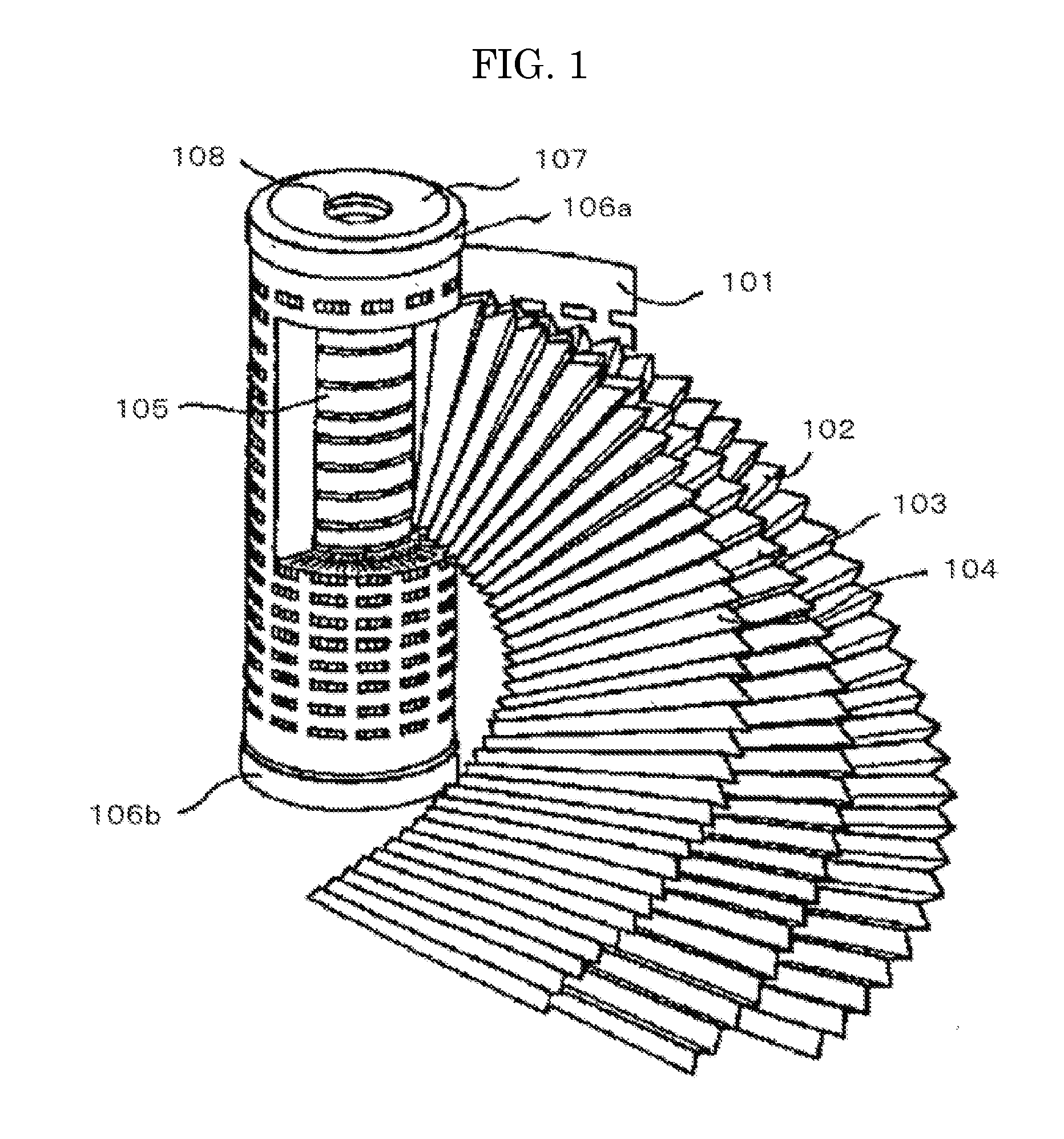Filtration filter and method for producing the same
a technology of filtration filter and filter body, which is applied in the direction of filtration separation, membranes, separation processes, etc., can solve the problems of insufficient surface modification at the plane portions, short life of the cartridge, and low flow rate, so as to achieve high water resistance, high acid resistance, and high chemical resistance
- Summary
- Abstract
- Description
- Claims
- Application Information
AI Technical Summary
Benefits of technology
Problems solved by technology
Method used
Image
Examples
synthesis example 1
[0286]An addition reaction was initiated and proceeded using A-1420 manufactured by Daikin Chemical Sales Ltd. (F(CF2)4—CH2CH2OH) and ethylene oxide (C2H4O) in the manner as described in S. M. Heilmann et al., J. Fluorine Chem, 59, 1992, 387-396 to thereby obtain a fluorosurfactant expressed by the following structural formula 1. The compound expressed by the structural formula 1 had a rate of hydrophilic group substitution of 28.9%.
example 1
Production of Cartridge 1
—Preparation of Semi-Baked Film—
[0287]To 100 parts by mass of polytetrafluoroethylene fine powder having a number average molecular weight of 6,200,000 (POLYFLON fine powder F104U, manufactured by DAIKIN INDUSTRIES, LTD.), 27 parts by mass of hydrocarbon oil (ISOPAR manufactured by Esso Sekiyu K. K.) was added as an extrusion aid, and the obtained paste was extruded in the shape of a rod. The extruded paste was subjected to calendering at the speed of 50 m / min. by a calender roller heated at 70° C. to thereby prepare a polytetrafluoroethylene film. This film was then placed in a hot air drying oven having the temperature of 250° C. to dry and remove the extrusion aid, to thereby prepare an unbaked polytetrafluoroethylene film having an average thickness of 100 μm, average width of 150 mm, and specific gravity of 1.55.
[0288]A surface (a heating surface) of the obtained unbaked polytetrafluoroethylene film was heated by a roller (surface material: SUS316) heat...
example 2
Production of Cartridge 2
[0292]A surface treated cartridge 2 of Example 2 was produced in the same manner as in Example 1, except that the hydrophilization treatment was changed as follows.
—Hydrophilization of Cartridge—
[0293]In a methanol solution containing 5% by mass of pentaethylene hexamine (manufactured by Wako Pure Chemical Industries, Ltd.) and 1% by mass of an epoxy compound (DENACOL EX411, manufactured by Nagase ChemiteX Corporation), 2.5% by mass of hydroxyethylenediamine triacetic acid (manufactured by DOJINDO LABORATORIES) and 1.0% by mass of DBU (manufactured by Wako Pure Chemical Industries, Ltd.), the cartridge 1 was immersed for 10 minutes, and then the cartridge 1 was taken out from the solution and subjected to annealing for 30 minutes at 100° C. in atmospheric air. Thereafter, the processed cartridge 1 was immersed in water for 30 minutes and then immersed in methanol for 30 minutes to carry out washing, and then dried, to thereby produce a surface treated cartri...
PUM
| Property | Measurement | Unit |
|---|---|---|
| Mass | aaaaa | aaaaa |
| Mass | aaaaa | aaaaa |
| Mass | aaaaa | aaaaa |
Abstract
Description
Claims
Application Information
 Login to View More
Login to View More - R&D
- Intellectual Property
- Life Sciences
- Materials
- Tech Scout
- Unparalleled Data Quality
- Higher Quality Content
- 60% Fewer Hallucinations
Browse by: Latest US Patents, China's latest patents, Technical Efficacy Thesaurus, Application Domain, Technology Topic, Popular Technical Reports.
© 2025 PatSnap. All rights reserved.Legal|Privacy policy|Modern Slavery Act Transparency Statement|Sitemap|About US| Contact US: help@patsnap.com



